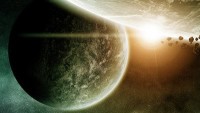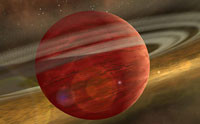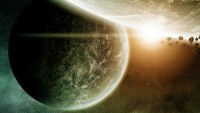By Dr. Danny Faulkner The purpose of the Kepler mission and other searches for extrasolar planets is to find evidence that life is common in the universe. …read more Read more here: AIG Daily
The big bang hypothesis demands that there should be stars with zero metal content. …read more Read more here: creation.com
By Dr. Danny Faulkner A news story in February 2016 reported the first detection of an atmosphere around a super-earth extrasolar planet, 55 Cancri e. …read more Read more here: AIG Daily
By Dr. Danny Faulkner This first direct confirmation of gravitational waves is another example of how far out and cool God’s creation can be. …read more Read more here: AIG Daily
The discovery of gravitational waves that match Einstein’s general relativity theory for a binary black hole merger is an example of solid operational science. …read more Read more here: creation.com
By Dr. Danny Faulkner The observations themselves merely tell us that green pea galaxies have unusual amounts of doubly ionized oxygen atoms, not an evolutionary story. …read more Read more here: AIG Daily
By Dr. Danny Faulkner Pluto fans may be encouraged by the announcement that astronomers think they have evidence there is a ninth planet after all, a sort of replacement for Pluto. …read more Read more here: AIG Daily
‘Dark ages’ not Dark! Medieval scientists knew about the tiny size and sphericity of Earth, and proposed that it rotates. Learn about Ptolemy, Boëthius, Buridan, and Oresme. …read more Read more here: creation.com
By Dr. Danny Faulkner If you make New Year’s resolutions, why don’t you decide this year to get outside at night away from city lights more often to enjoy God’s beautiful creation? …read more Read more here: AIG Daily
This new book examines a possibility for the identity of the Bethlehem star. …read more Read more here: creation.com
The distribution of the galaxies appears anything but random and stands in stark contrast to the model promoted by big bang cosmologists. …read more Read more here: creation.com
By Dr. Andrew A. Snelling This contribution is designed to document the radioisotope dating data for groups of chondrites, stony achondrites, pallasites and mesosiderites, and irons. …read more Read more here: AIG Daily
The discovery of planets around distant stars isn’t new. Roughly 2,000 exoplanets are confirmed to exist. But astronomers claim to have direct evidence that a giant planet is in the process of forming. How strong is this claim? More… …read more Read more here: icr.org
Could an anomaly found in the map of the cosmic microwave background be from one universe bumping up against another? …read more Read more here: creation.com
Earlier this year, New Horizons flew past dwarf planet Pluto and its sister Charon, rapidly capturing data. That information continues to trickle in, revealing a surprisingly smooth heart-shaped plain called “Tombaugh Regio.” The countless craters expected from billions of years’ worth of impacts are nowhere to be found. More… …read more Read more here: icr.org
The European Space Agency’s Rosetta probe travelled all the way to comet 67P/Churyumov-Gerasimenko to collect unprecedented cometary details. The space probe keeps sending unexpected particulars about the comet—particulars with implications far beyond the comet itself. More… …read more Read more here: icr.org
Sneak peek of latest Creation magazine. As scientists digest information from Pluto, it’s obvious the planet is young and defies long-age expectations. …read more Read more here: creation.com
New methods using increased precision have allowed mankind to answer a fundamental question: Do other stars have planets? Natural philosophers have pondered this question for centuries. Johannes Kepler imagined beings on other planets in his book, The Dream, considered the first work of science fiction. Today’s scientists are finally able to move from fiction to fact. The answer is: Yes! Other stars do have planets. A follow-up question for creationists (and evolutionists) is: what does it mean for our worldview? Read More: Exoplanets – creation.com
Researchers in the field of astronomy have recently announced what is described to be a ‘truly monstrous’ structure, consisting of a ring of galaxies around 5 billion light-years across. Reported findings show that the seemingly unprecedented galactic ring, which was revealed by nine Gamma-Ray Bursts (GRBs), is located 7 billion light-years away. GRBs are thought to be the result of massive stars collapsing into black holes, ostensibly at the end of the stars’ lives. Because black holes are typically found inside galaxies, astronomers say the ring of GRBs is evidence of a gigantic galaxy ring. Beacons can be used to [More]
Scientists have announced indirect evidence of liquid water on the surface of Mars, raising hopes among secular scientists that life may be present on the “red planet.” But why do they hope for this—and are such hopes realistic? More… …read more Read more here: icr.org
Along with fudge factors, such as Dark Matter used to explain the big bang, the chameleon particle has been introduced even though there’s no evidence it exists. …read more Read more here: creation.com
By Dr. Danny Faulkner While water is a common substance in the universe, the earth is the only place that we know for certain where liquid water exists. …read more Read more here: AIG Daily
How did our solar system get here? Those who dismiss any possibility of creation imagine ways that pure natural forces might set in motion the sun, each unique planet and their moons. New computer modeling results seem to show promise—but only when they overlook or assume obvious and important factors. More… …read more Read more here: icr.org
By Dr. Danny Faulkner We here at Answers in Genesis believe that life is unique to Earth, so is the discovery of Kepler-452b a problem for us? …read more Read more here: AIG Daily
Progressive creationist Hugh Ross has declared as fact something about the alleged big bang that even evolutionists want to be true but have not claimed. …read more Read more here: creation.com
Despite claims that stars formed from primordial clouds of gas, the known laws of physics show that to be impossible. …read more Read more here: creation.com
By Dr. Danny Faulkner The asymmetry between matter and antimatter is not a problem if God created the universe as Genesis 1 says that He did. …read more Read more here: AIG Daily






































